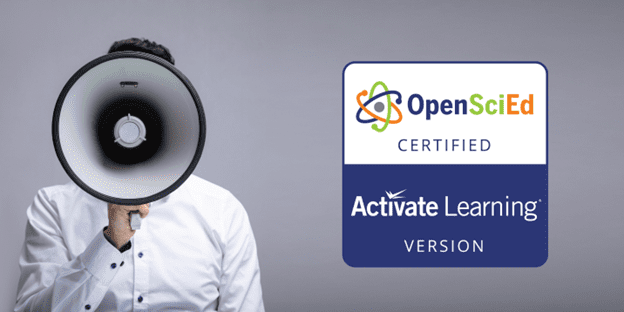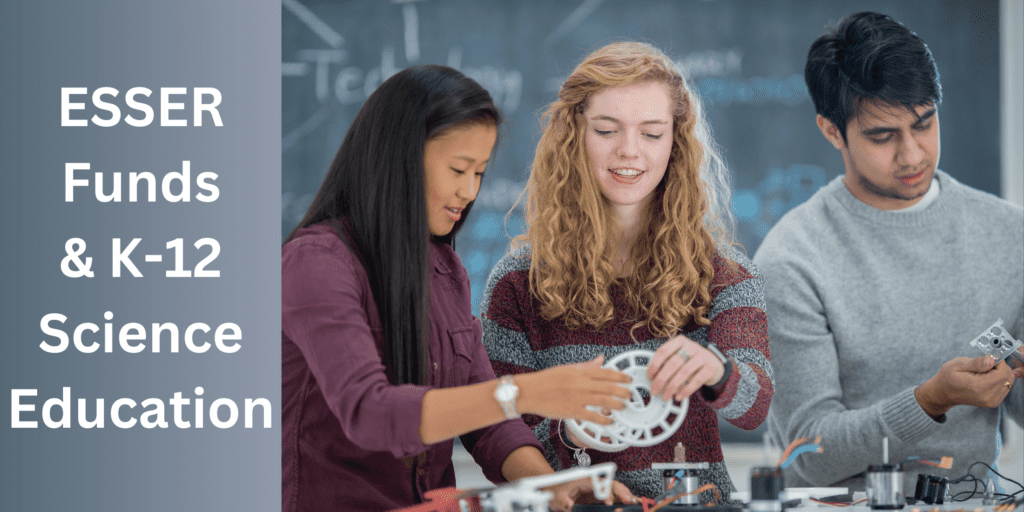Empowering Student Voices: The Power of Equitable Discussions in Science Education with OpenSciEd

Quick Take: Our recent Snapshot Webinar on 3D learning uncovers the transformative power of OpenSciEd in fostering equitable discussions in science education. From valuing diverse perspectives to practical strategies for immediate implementation, this webinar recap empowers science educators to create richer, more inclusive learning experiences that makes all students feel known, heard, and supported. Webinar video replay and FREE resources included.
Equitable Discussions in Science Education
Inclusion. Collaboration. Voice. These ideals are at the heart of equitable science instruction. Science education has long been a cornerstone of fostering critical thinking and curiosity among students. But how can we ensure that this transformative experience is accessible and inclusive to all learners, regardless of their backgrounds or abilities?
The answer lies in equitable discussions, a powerful tool in the hands of educators committed to making science education truly universal. But fostering classrooms where all students are known, heard, and supported requires intention and skill from teachers.
In the third installment of our webinar series, Snapshot Webinars on 3-Dimensional Learning, Rebecca Garelli (Professional Learning Specialist at Activate Learning) offered tangible strategies, using a lesson from OpenSciEd, to help K-8 science teachers facilitate more equitable classroom discussions. Whether you're new to equity work or a seasoned expert, this webinar recap will provide takeaways to make your science classroom more inclusive.
Let’s dive in! 🚀
Shifting Classroom Culture by Valuing Diverse Ways of Knowing
Current science education standards, like the Next Generation Science Standards (NGSS), highlight the need to support an equity vision in K-12 science instruction. The National Research Council's Framework for K-12 Science Education devotes an entire chapter to equity and diversity in science classrooms. Why this focus on equity in national standards?
As the Framework states, "Realizing this potential [of the NGSS] is particularly important in relation to students of color, students who speak first languages other than English, and students from low-income communities." Despite decades of reform, these student groups have often been denied access to quality science learning opportunities. With shifting student demographics, preparing scientifically literate citizens requires providing meaningful science education access to all learners. This is crucial to prepare students for STEM careers.
Traditionally, science classrooms have privileged certain forms of expression, interaction, and knowledge production. Western technical academic language, teacher-driven conversations, and textbook facts took center stage. Students' existing knowledge, cultural assets, ways of communicating, and approaches to sensemaking often went unrecognized.
Equitable discussions are more than just polite exchanges of ideas. Equitable classrooms value diverse forms of literacy, discourse, and thinking. All students have a diverse experiences, ideas, and language that might not be expressed in academic language. Building classroom culture involves widening what counts as valuable knowledge and who is seen as a contributor. Underserved student groups find their voices amplified and their curiosity nurtured. This is at the core of shifting classroom culture to one that facilitates equitable learning.

Equity in Action: Strategies and Tools that Shape Classroom Culture
How do equitable science discussions play out in real classrooms?
Using an OpenSciEd lesson from Unit 8.1 (Forces at a Distance) as context, Rebecca provided video examples for participants to analyze. Using an observation tool, participants examined who was engaged in discussions, how the teacher solicited ideas, whose ways of knowing were privileged, and more. This moves from theory to the specifics of practice gave a tangible equity lens for noticing teaching and learning behaviors.
For instance, in one classroom video the teacher actively elicited ideas from all students, even quieter voices. When students shared unconventional hypotheses, the teacher welcomed these as valuable contributions rather than dismissing them as wrong. Students were positioned as sensemakers, with space to sort out developing theories together. This contrasted with a non-equitable clip where the teacher labeled student ideas as "garbage" and shut down discussion.
To grasp the concept better, let's explore a few scenarios where equitable discussions thrive:
Scenario 1: The Copper Conundrum
In a middle school science class, students are exploring the inner workings of speakers. Markel raises a question: Why is the coil made of copper? This seemingly simple question sparks a lively discussion. Instead of dismissing it, the teacher encourages Markel to share his thoughts. As the discussion unfolds, students realize that Markel's query opens doors to understanding the role of materials in the speaker's construction.
Scenario 2: Fostering Inquiry
A group of students is conducting an experiment involving magnets and coils. One student, Ashley, suggests testing a different material for the coil. The teacher, in line with equitable discussions, encourages the class to explore this idea. By doing so, they uncover valuable insights into the relationship between materials and magnetism.
Promoting equitable discussions doesn't require a complete overhaul of your teaching approach. In addition to free, downloadable resources that Rebecca shared, the webinar provided some practical strategies and tools you can use immediately:
- Active Listening and Respectful Dialogue: Encourage students to actively listen to their peers and respond respectfully. Teach them the art of constructive feedback, emphasizing the importance of acknowledging different viewpoints.
- Valuing Diverse Perspectives: Create an atmosphere where diverse perspectives are celebrated. Showcase the uniqueness of each student's contributions, fostering an environment where everyone feels valued.
- Effective Questioning Techniques: Use open-ended questions to stimulate critical thinking. Encourage students to explore concepts further and ask probing questions, deepening their understanding.
- Online Platforms for Collaboration: Leverage online platforms that facilitate collaborative discussions. These platforms provide a space for students to engage in discussions outside of the classroom, promoting inclusivity.
- Discussion Prompts and Activities: Incorporate discussion prompts and activities that promote equitable participation. Provide clear guidelines for how students can engage in meaningful conversations.
OpenSciEd: A Trailblazing Catalyst for Equitable Learning in Science

OpenSciEd is at the forefront of this educational transformation. It goes beyond being a mere curriculum; it's a pedagogical paradigm shift that guides teachers in implementing equitable science instruction for all students. This isn't about deploying add-on strategies when needed; equitable instructional practices are the beating heart of OpenSciEd's materials. Equity is at its core.
The flexibility of OpenSciEd's curriculum allows educators to adapt it to their unique classroom contexts. But what truly sets it apart is its profound connection to students' interests, identities, and life experiences. It aligns seamlessly with the goals and needs of their communities, ensuring that science isn't an abstract concept but a tangible, relevant part of their lives.
It actively promotes culturally sustaining approaches, providing students with opportunities to engage with science using their full linguistic repertoires. This means embracing multiple languages to make science accessible and engaging for all, going beyond the confines of traditional written or spoken expression and employing multi-modal techniques (as we explored in our webinar, Making Thinking Visible).
OpenSciEd is a powerful tool for promoting equitable learning because it recognizes and celebrates the diverse ways in which students express their understanding. By doing so, it encourages students to appreciate these differences in each other.
Reflection for Classroom Application
“Student sensemaking is not straightforward and may not seem logical to others, but is logical, rich, and meaningful to the student. This is something I think I will need to get more comfortable with.” -- Karen Postlethwait (webinar participant)
With research context, analysis protocols, and video examples covered, Rebecca closed the webinar by having teachers reflect on challenges and applications for their own practice. When equity work feels hard, it helps to connect with like-minded educators trying to facilitate change.
As one participant noted, getting students to move beyond "getting the grade done" and engage in collaborative knowledge construction can be a hurdle. But hearing from fellow science teachers on common obstacles makes one feel less alone in the process. There is community in the continued effort to dismantle systemic inequities and create classrooms where all learners have equal seats at the table.
Although shifts in mindset and practice take time, teachers don’t have to embark on this equity journey alone. At Activate Learning, we offer educators OpenSciEd implementation support every step of the way (including all materials, a robust digital platform, science kits, and personalized professional learning). This ensures that teachers can gain the insights and tools they need to better serve all students on the path to scientific literacy.
For more insights, watch the webinar recording below and download the free resources Rebecca shared HERE.
Ready for the next webinar on 3-Dimensional Learning?
We are too! If you missed this first three webinars, don’t worry. Read recaps of previous webinars on our blog HERE. There are still two more webinars left in the series. And register for upcoming webinar sessions in this series HERE to catch the Aha Moments for your teaching and learning journey! 🚀
* * * * *



![OpenSciEd Universal Design for Learning Header Image (OSE students by nicolejbolduc) [PHOTO: 7th grade students analyzing data together in an exercise from OpenSciEd Unit 6.4. CREDIT: @nicolejbolduc/Twitter]](https://activatelearning.com/wp-content/uploads/bb-plugin/cache/OpenSciEd-Universal-Design-for-Learning-Header-Image-OSE-students-by-nicolejbolduc-1024x512-panorama-56d0d80e31176175c2818d16d199cd62-.png)
